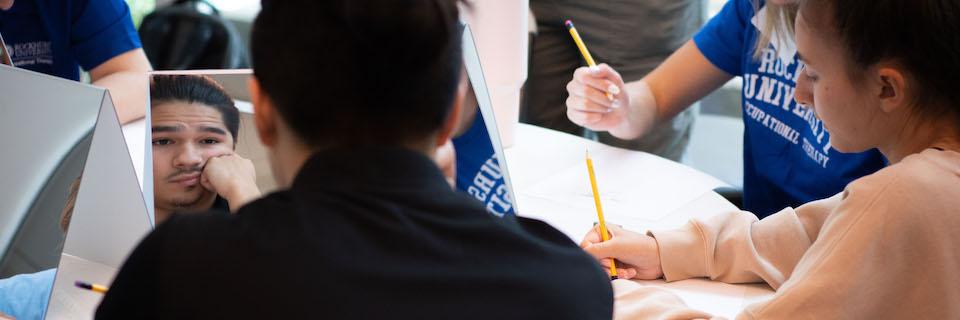To Better Understand Their Patients, OT Students Bust Out the Drawing Pad

It’s been a while since first-year occupational therapy student Lindsey Fuentes sat down to really draw something.
The mother of three said she does scribble shapes by request for her children. But it’s been a while since she really focused on observing a person or object and translating what she sees onto paper.
“It was kind of intimidating at first,” she said.
But this was about more than reconnecting with her artistic side. For a group of occupational therapy graduate students in the psychosocial lab course led by Tammy Bruegger, OTD, assistant professor of occupational therapy, a trip Friday to the Greenlease Gallery and Panacea Project Space on the Rockhurst University campus was an opportunity to build important skills related to their work in the field during a workshop focused on mindfulness.
“This is hitting many different things that we've been talking about,” Bruegger said. “We designed this to help them to practice mindfulness in order to develop their observation skills, consider their own biases and look at people who have diverse needs or with disabilities as people first.”
The opportunity coincided with the opening of “See Me: Portraits of Neurofibromatosis,” an exhibition of oil paintings by Rachel Mindrup, the Richard L. Deming, M.D., Endowed Chair in Medical Humanities and associate professor at Creighton University, that will be on view in the Greenlease Gallery and Panacea Project Space through Dec. 3. In the mindfulness workshop designed by Bruegger, Mindrup and Kristy Peterson, director of the gallery, the artist first met with the students to talk about the exhibition — portraits of individuals with neurofibromatosis, made with input from the individuals and with short biographies written by each subject. For Mindrup, the project stems from her experience as the parent of a son with the condition. But it’s also meant to help viewers understand a disease that manifests itself in different ways in different patients and remind them of the humanity that is always a part of health care.
Then, students broke into two groups – half focused on a “deep looking” exercise of the works in the gallery and the other focused on drawing either a self-portrait or Antwan Winkfield, whose portrait by Mindrup is featured in the show and was there to talk about his experience with NF and to serve as a model. The quality of the drawing was not necessarily the focus. More important, Mindrup said, was the students honing their skills of observation. Because to observe something, she said, is to understand it more completely.
“Don’t just read a patient chart and think that you have an accurate picture of who this person is,” she said. “You’re going to need to be vigilant and observant in your evaluations.”
Bruegger said OTs use a variety of activities, or “occupations,” to treat a wide scope of conditions. Improving observation, she said, allows OTs to approach therapy for their patients that best meets their needs. Fuentes said she caught herself at one point drawing what she thought she looked like instead of observing her own face. When she did zero in, she found herself noticing details she hadn’t before. It was a reminder to look at the whole person when it comes to the patient-provider relationship and developing treatment.
“You really need to focus on what you see in front of you. And that was harder to do,” she said of the drawing exercise. “You need to know your patients, because there are background pieces that also matter, and even those things in the background can affect outcomes.”







